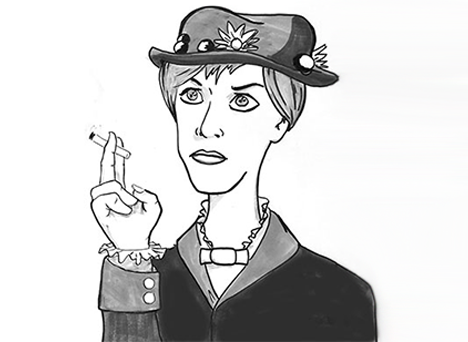One Punk Goes to the Movies: Mary Poppins and Walt Disney’s Inadvertent Feminist Agenda


In my role as a film critic, I watch a lot of movies. Usually, they’re new films that have just been released into theaters, or maybe older ones that I might have missed over the years—ones that have something to offer to the ever-developing art form. However, in my role as the father of a three-and-a-half-year-old, I also watch a lot of “kids” movies. These, for the most part, don’t have a whole lot to offer in a critical capacity but nonetheless serve a great function to me getting anything at all done in the way of work. I’ve sat through my share of stinkers, as I’m sure most parents have, but every now and then I run across a family film that’s much more than it seems. Sometimes it simply doesn’t suck as much as usual, but sometimes—rarely, mind you—it’s a truly great piece of cinema with a surprising amount to say. Walt Disney’s 1964 production of Mary Poppins is such a film. On the surface, it’s nothing more than the typical tale of magic and wonderment, but just below, there’s something else—something I hadn’t expected to find when watching a film that we’ve all, no doubt, seen at least once in our lives.
I’ll say it outright: Mary Poppins is the closest thing to a feminist declaration any major studio would even dream of releasing in 1964—and that it was Walt Disney Studios who released it, well, that’s just gravy. Walt Disney was no feminist. It’s doubtful he’d ever even heard the word in his lifetime. He had no intention or desire to make a film about such a subject. What he was interested in was good old-fashioned, wholesome family entertainment. Ultimately, he got what he was after—but he got something else, too.
It’s 1910, London. As the film begins, we’re first introduced to Mrs. Winifred Banks (the amazing Glynis Johns). She comes blustering into her home after a protest that ended in arrests and violence. She’s a proud crusader for women’s equality, and her song, “Sister Suffragette,” is an anthem to that cause (“From Kensington to Billingsgate / One hears the restless cries! / From ev’ry corner of the land: ‘Womankind, arise!’”). She’s proud of what she and her fellow women have accomplished and has no intention of giving up the fight, no matter what her stuffy English husband has to say about it.
This husband, Mr. Banks (David Tomlinson), is a traditional Edwardian patriarch who runs his home like the lord of a great castle. He expects everything to be just so, even though it rarely is. He lives his life in an ignorant fantasy world made up of perfect children, doting wives, and respectful servants. He’s not an evil man, but, as Mary puts it, he “can’t see past the end of his nose.” In fact, as we meet him, his children, Jane and Michael (Karen Dotrice and Matthew Garber), are missing, having run away from yet another nanny. They need a firm hand, Mr. Banks declares, and a search for a new nanny is underway. It’s interesting to note that Mr. Banks refuses to participate in the lives of his children in any way, other than projecting his imagined perfections onto them. They aren’t bad kids, mind you, they’re just prone to flights of fancy.
Enter Mary Poppins (Julie Andrews, nailing her screen debut like no other could have). While she may work in what is considered a “feminine” profession, her shrewdness with Mr. Banks would have been shocking in 1910, and was to some in 1964 as well. She dictates the terms of her employment, not her boss, the man, Mr. Banks. She simply refuses to be mistreated in any way. When Mr. Banks demands to know just why several grimy chimney sweeps are doing dancing around his living room, Mary replies, first crossly, “First of all, I would like to make one thing clear,” then sweetly yet matter-of-factly, “I never explain anything.” She’s stern, but she’s fair. She will not tolerate injustice, but she also won’t tolerate laziness or neglect of duty. She often appears to be against having fun, but always relents with not much prodding. And her sense of fun is unlike anything else you’ve seen.
Just as Mary won’t be tied down in business, she also won’t in romantic relationships. She goes where she pleases when she pleases. The ragamuffin Bert (Dick Van Dyke)—a part-time street performer, artist, and chimney sweep—is clearly in love with Mary, but makes no overt advances, and never once cramps her independent style. In this way, Bert is an atypical male character for films of that time (or any time if you really want to get down to it). His role is to help Mary, not to change her or to convince her to give up her lifestyle. The man doesn’t woo the woman into settling down, and there’s certainly no romantic comedy third act where she finally realizes that his stalker antics are charming instead of criminal. Quite the opposite. When Mary decides it’s time to leave, Bert offers no objection. He knows the type of woman Mary is and would never dream of getting in her way. Bert is an ally, something I find quite refreshing.
Things go haywire when Mary, a master of reverse psychology, contrives to have Mr. Banks take the children to work with him (he works at a bank, go figure). Things turn sour when Jane and Michael would rather give their money to an old woman selling bird feed than invest it in the bank. Mr. Banks, being a pure and righteous capitalist, naturally scoffs at the idea. A near riot breaks out in the bank, and the children go missing once again.
Here’s the interesting, and somewhat depressing, if not one-hundred-percent typical, part of how this plays out: Mr. Banks is told repeatedly throughout the film by the women in his life that he should listen, be more attentive, and take more of an interest in his children. He scoffs at the notion every time. But, after the bank scene, Bert has a sort of heart to heart with him and he finally sees the error in his ways. It’s nearly infuriating (but as I said, one-hundred-percent typical) that it takes a man to tell Mr. Banks the exact same thing a woman did for him to understand it. Bert, the ally, understood the female perspective from the onset, and when he saw that Mr. Banks was too pig-headed to listen, he stepped in.
I highly doubt that Disney saw it this way. I’m sure his train of thought was that Mr. Banks had simply come around to the idea. But with the benefit of hindsight and the enlightened political climate we (hopefully) live in today, there’s no other way to read it than the way I’ve described. Mr. Banks, while not a bad man, per se, only opened his mind to a new idea when it was presented by a fellow male. And bless Bert for trying. How many true feminist allies can you think of portrayed on film?
It’s with this same benefit of hindsight where some problematic issues arise, however. For example, the issue of class and wealth disparity is never mentioned, even though it’s a perfect film to address the topic. More troubling though (and this is certainly, at least in part, due to when the film was released) is the total lack of intersectionality. To my recollection, there isn’t a single person of color in the entire film. Does that take away from what the film still achieves for its time? That’s up to each viewer to decide, but it’s still worth mentioning.
Mary Poppins currently holds a 100% rating on Rotten Tomatoes, if that sort of thing interests you. And it really is that good. If you pay attention, you’ll find that in addition to its ahead-of-its-time view of contemporary social order, it’s chock full of great one-liners that I guarantee you’ll start peppering into your conversation. I laugh out loud every time I hear, “Mary Poppins, practically perfect in every way.”
Walt Disney died two years after the release of Mary Poppins. He considered it among the best work he’d ever been involved with. I wonder if he would understand this analysis of his beloved film if he were alive today. I think he’d pull a Mr. Banks and scoff at the notion that Mary Poppins was some sort of “feminist.” I think he would have trouble grasping the concept. Maybe Bert would have to explain it to him. Who knows? What I do know is that, intentional or not, Disney put a feminist on the big screen. More than one in the same film, in fact. He also properly identified how an ally should act, and got some good jabs at capitalism in for good measure. Maybe he was high or something.
Originally published by RAZORCAKE.
